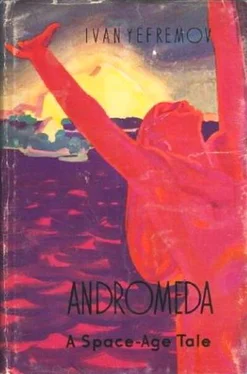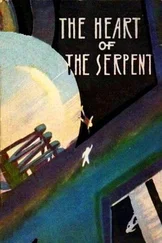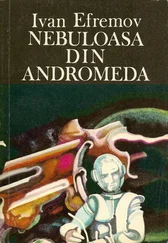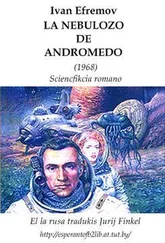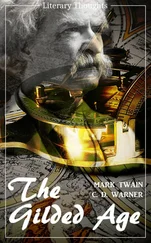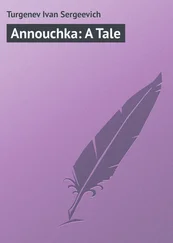Ivan Yefremov - Andromeda (A Space-Age Tale)
Здесь есть возможность читать онлайн «Ivan Yefremov - Andromeda (A Space-Age Tale)» весь текст электронной книги совершенно бесплатно (целиком полную версию без сокращений). В некоторых случаях можно слушать аудио, скачать через торрент в формате fb2 и присутствует краткое содержание. Город: Moscow, Год выпуска: 1959, Издательство: FOREIGN LANGUAGES PUBLISHING HOUSE, Жанр: Фантастика и фэнтези, на английском языке. Описание произведения, (предисловие) а так же отзывы посетителей доступны на портале библиотеки ЛибКат.
- Название:Andromeda (A Space-Age Tale)
- Автор:
- Издательство:FOREIGN LANGUAGES PUBLISHING HOUSE
- Жанр:
- Год:1959
- Город:Moscow
- ISBN:нет данных
- Рейтинг книги:5 / 5. Голосов: 1
-
Избранное:Добавить в избранное
- Отзывы:
-
Ваша оценка:
- 100
- 1
- 2
- 3
- 4
- 5
Andromeda (A Space-Age Tale): краткое содержание, описание и аннотация
Предлагаем к чтению аннотацию, описание, краткое содержание или предисловие (зависит от того, что написал сам автор книги «Andromeda (A Space-Age Tale)»). Если вы не нашли необходимую информацию о книге — напишите в комментариях, мы постараемся отыскать её.
Andromeda (A Space-Age Tale) — читать онлайн бесплатно полную книгу (весь текст) целиком
Ниже представлен текст книги, разбитый по страницам. Система сохранения места последней прочитанной страницы, позволяет с удобством читать онлайн бесплатно книгу «Andromeda (A Space-Age Tale)», без необходимости каждый раз заново искать на чём Вы остановились. Поставьте закладку, и сможете в любой момент перейти на страницу, на которой закончили чтение.
Интервал:
Закладка:
Mven Mass went back to his study, called the Institute of Metagalactics, that worked at night, and asked them to send him stereotelefilms of a few galaxies next evening. Having obtained their consent he went up to the roof of the inner building where he kept his long-range leaping apparatus. Mven Mass was very fond of this unpopular sport and had achieved a fair degree of skill. He strapped the helium container to his body, leaped agilely into the air and for a second switched on a tractor propeller that was driven by a light accumulator. He described an arc about 600 metres long and, landing on a ledge of the Catering House, repeated the jump. In five such leaps he reached a small garden under a limestone cliff where he landed on an aluminium tower, removed the apparatus and slid down a pole to the ground and so to his hard bed standing under a huge plane-tree.
The African fell asleep to the rustling of the leaves of the giant tree.
The Fete of the Flaming Bowls got its name from the well-known poem by the poet-historian Zann Senn in which he describes the ancient Indian custom of selecting the most beautiful women to carry swords and bowls containing flaming aromatic incense to heroes about to set out for the performance of great deeds. Swords and bowls were no longer in use but remained as the symbol of heroism. Heroic deeds had grown to countless numbers amongst the bold and energetic population of the planet. A tremendous capacity for work, possessed in the past by only those few people who were known as geniuses, depended entirely on the physical strength of the body and an abundance of hormone stimnlators. Correct physical training for thousands of years had made the average person on the planet the equal of the heroes of antiquity, insatiable in his desire for heroic deeds, love and knowledge.
The Fete of the Flaming Bowls was the women’s spring festival. Every year in the fourth month after the winter solstice or, according to the old calendar, in April, the most beautiful women on Earth took part in dances, singing and gymnastics. The finest shades of beauty of the various races that showed in the mixed population of the planet were to be seen here in inexhaustible variety like the facets of a precious stone; they gave endless pleasure to their audiences which included everybody from scientists and engineers, tired out with their meticulous labours, to inspired artists and the still youthful pupils of the Third Cycle schools.
No less beautiful was the Festival of Hercules, the men’s autumn festival celebrated in the ninth month. At this festival young men coming of age reported on the Herculean labours they had performed. Later it became the custom on these occasions to review all the noteworthy deeds and achievements of the past year. And so the festival had become a general one, celebrated by both men and women, and lasting three days — the Day of Useful Excellence, the Day of Higher Art, and the Day of Scientific Audacity and Fantasy. One year Mven Mass had been elected hero of the first and third days.
Veda Kong sang a number of songs. Mven Mass appeared the gigantic Solar Hall of the Tyrrhenian Stadium during her performance. He found the ninth sector of the fourth radius where Evda Nahl and Chara Nandi were sitting and stood there in the shadow of an arcade listening to Veda’s low deep voice. She was dressed in white. Her blonde head thrown back and her face turned to the upper galleries of the hall, she was singing a song of joy and to the African she seemed the very incarnation of spring. Every member of the audience pressed one of the four buttons in front of him. The golden, blue, emerald or red lights flickering on the ceiling showed the artist to what extent the performance had been appreciated and took the place of the noisy applause of former days.
Veda finished singing and was awarded by a bright cluster of gold and blue lights amongst which the very few green ones were completely lost. Her face flushed with excitement as usual, she ran to her friends. At that moment they were joined by Mven Mass whom they heartily welcomed.
The African looked round the stadium in search of his teacher and predecessor but Darr Veter was nowhere to be seen.
“Where have you hidden Darr Veter?” he asked jokingly, turning to the three women.
“And where have you hidden Renn Bose?” Evda Nahl replied, and the African hastily avoided her penetrating glance.
“Veter is digging holes in South America,” said the more kind-hearted Veda and a shadow passed over her face. With a protective gesture Chara Nandi pulled Veda towards her, pressing her cheek against Veda’s. The faces of the two women were vastly different but possessed a gentle tenderness which lent them similarity.
Chara’s eyebrows; straight and low under a high forehead, resembled the outline of a soaring bird and were in perfect harmony with her long narrow eyes. Veda’s eyebrows slanted upwards.
“A bird flapping its wings,” thought the African. Chara’s thick, shining; black hair lay on her neck and shoulders contrasting sharply with Veda’s fair hair, piled high on her head.
Chara glanced at the clock in the domed roof and got up. Her dress astounded the African. On the girl’s smooth shoulders lay a platinum chain leaving her high neck open. The chain was fastened below her throat by a gleaming red tourmaline.
Her firm breasts, like wide upturned bowls carved with a very delicate chisel, were almost completely exposed. Between them, stretching from the tourmaline clasp to her belt ran a narrow strip of dark purple velvet. Similar strips, running across the middle of each breast, were held taut by the chain and joined on her bare back. The girl’s very narrow waist was encircled by a white belt besprinkled with black stars and fastened by a platinum buckle in the form of a crescent, from which a strip of dark purple velvet hung down to her knees. Attached to her belt behind was what seemed like half a long skirt of heavy white silk, also decorated with black stars. The dancer wore no jewels with the exception of glittering buckles on her tiny black slippers.
“It will soon be my turn!” said Chara calmly making her way towards the arcade exit; she glanced at Mven lass and disappeared, accompanied by whispered questions and thousands of curious glances.
The stage was occupied by a gymnast, a beautifully proportioned girl no more than eighteen years old. In the golden floodlights, to the recitative of the music, she went through an amazingly rapid succession of leaps, springs and turns, balancing with unbelievable equilibrium to slow, lyrical passages of music. The audience awarded her performance with a multitude of golden lights and Mven Mass thought that it would not be easy for Chara Nandi to dance after such a successful number. He looked anxiously at the faceless multitude of people opposite and suddenly noticed the artist Cart Sann sitting in the third sector. The latter greeted him with a gaiety that the African felt out of place — who, if not the artist who had painted Chara’s picture as the Daughter of the Mediterranean, should have been perturbed at the outcome of her performance.
The African was just thinking that after his experiment he would go to see the Daughter of the Mediterranean when the lights overhead were extinguished. The transparent floor of organic glass gleamed with the cherry-red light of hot iron. Streams of red light poured out from under low footlights around the stage. The lights moved back and forth keeping time with the marked rhythm of the melody and merging with the resonant song of the violins and the low hum of bronze strings. Mven Mass was somewhat staggered by the power and tempestuousness of the music and did not immediately notice Chara as she appeared in the centre of that flaming floor and began her dance at a Speed that took the onlookers’ breath away.
Читать дальшеИнтервал:
Закладка:
Похожие книги на «Andromeda (A Space-Age Tale)»
Представляем Вашему вниманию похожие книги на «Andromeda (A Space-Age Tale)» списком для выбора. Мы отобрали схожую по названию и смыслу литературу в надежде предоставить читателям больше вариантов отыскать новые, интересные, ещё непрочитанные произведения.
Обсуждение, отзывы о книге «Andromeda (A Space-Age Tale)» и просто собственные мнения читателей. Оставьте ваши комментарии, напишите, что Вы думаете о произведении, его смысле или главных героях. Укажите что конкретно понравилось, а что нет, и почему Вы так считаете.
